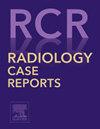The curious case of the protruding muscle: A case report of muscle hernia
Q4 Medicine
引用次数: 0
Abstract
Muscle hernias are an uncommon clinical entity, characterized by the protrusion of a muscle through the overlying weakened fascia. The most affected muscle is the tibialis anterior muscle, although other locations such as the upper limb are possible. Patients typically present with a palpable, soft-tissue mass that may be reducible upon physical examination. Imaging plays a critical role in accurately diagnosing muscle hernias, distinguishing them from other causes of palpable soft-tissue masses. Magnetic resonance imaging (MRI) is particularly valuable, as it allows detailed visualization of the muscle contour and the superficial fascial layers at the site of the abnormality. We report the case of a 32 years-old patient with a palpable mass of the thigh, presenting to our structure for an MRI, in which we concluded to a hernia of the vastus lateralis muscle.
肌肉突出的奇怪病例:肌肉疝1例报告
肌肉疝是一种罕见的临床疾病,其特征是肌肉通过其上的弱筋膜突出。最受影响的肌肉是胫骨前肌,尽管其他部位如上肢也有可能。患者通常表现为可触及的软组织肿块,经体格检查可缩小。影像学在准确诊断肌肉疝中起着至关重要的作用,将其与其他可触及的软组织肿块区分开来。磁共振成像(MRI)特别有价值,因为它可以详细地显示异常部位的肌肉轮廓和浅筋膜层。我们报告一个32岁的病例,患者可触及的肿块的大腿,呈现给我们的结构MRI,其中我们得出的结论是股外侧肌疝。
本文章由计算机程序翻译,如有差异,请以英文原文为准。
求助全文
约1分钟内获得全文
求助全文
来源期刊

Radiology Case Reports
Medicine-Radiology, Nuclear Medicine and Imaging
CiteScore
1.10
自引率
0.00%
发文量
1074
审稿时长
30 days
期刊介绍:
The content of this journal is exclusively case reports that feature diagnostic imaging. Categories in which case reports can be placed include the musculoskeletal system, spine, central nervous system, head and neck, cardiovascular, chest, gastrointestinal, genitourinary, multisystem, pediatric, emergency, women''s imaging, oncologic, normal variants, medical devices, foreign bodies, interventional radiology, nuclear medicine, molecular imaging, ultrasonography, imaging artifacts, forensic, anthropological, and medical-legal. Articles must be well-documented and include a review of the appropriate literature.
 求助内容:
求助内容: 应助结果提醒方式:
应助结果提醒方式:


